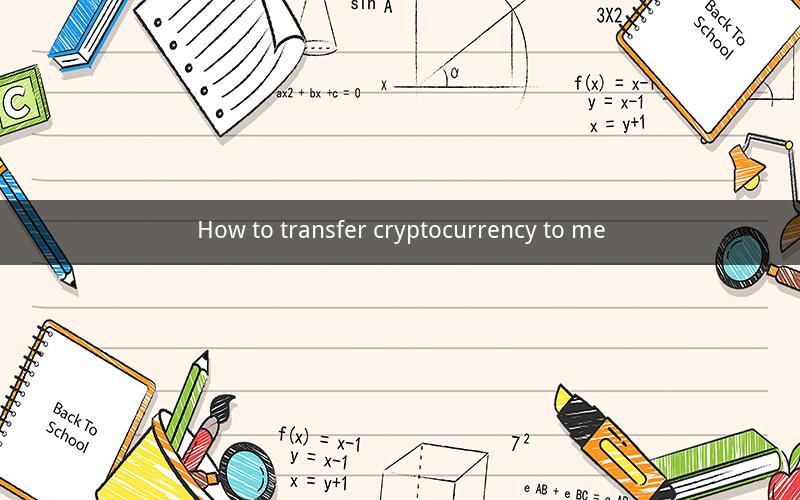
Directory
1. Introduction to Cryptocurrency Transfer
2. Understanding Cryptocurrency Wallets
3. Identifying the Recipient's Wallet Address
4. Choosing a Cryptocurrency Exchange or Wallet
5. Sending Cryptocurrency to the Recipient
6. Confirming the Transfer
7. Potential Issues and Solutions
8. Security Measures to Ensure Safe Transfer
9. Monitoring the Transfer Process
10. Conclusion
1. Introduction to Cryptocurrency Transfer
Cryptocurrency transfer is a process that allows individuals to send digital assets from one wallet to another. With the rise of blockchain technology, transferring cryptocurrencies has become increasingly popular due to its speed, security, and low transaction fees. This article will guide you through the process of transferring cryptocurrency to someone else's wallet.
2. Understanding Cryptocurrency Wallets
Before initiating a transfer, it's essential to understand the different types of cryptocurrency wallets. There are several types of wallets, including hardware wallets, software wallets, and mobile wallets. Each wallet has its unique features and security measures.
- Hardware Wallets: These wallets store your private keys offline, making them more secure against hacking and theft. They are ideal for storing large amounts of cryptocurrency.
- Software Wallets: These wallets are installed on your computer or mobile device and allow you to send, receive, and store cryptocurrencies. They are more accessible but may be vulnerable to malware and hacking.
- Mobile Wallets: These wallets are available as mobile applications and offer convenience for users who want to access their cryptocurrency on the go.
3. Identifying the Recipient's Wallet Address
To transfer cryptocurrency to someone else's wallet, you need to obtain their wallet address. The wallet address is a unique string of characters that serves as the recipient's identity on the blockchain. You can find the wallet address on the recipient's cryptocurrency wallet or by asking them directly.
4. Choosing a Cryptocurrency Exchange or Wallet
To initiate the transfer, you need to choose a cryptocurrency exchange or wallet that supports the cryptocurrency you want to send. Ensure that the platform you choose is reliable and has a good reputation in the cryptocurrency community.
5. Sending Cryptocurrency to the Recipient
Once you have chosen a platform and obtained the recipient's wallet address, follow these steps to send cryptocurrency:
1. Log in to your chosen platform.
2. Navigate to the transfer or send section.
3. Enter the recipient's wallet address.
4. Enter the amount of cryptocurrency you want to send.
5. Review the transaction details and confirm the transfer.
6. Confirming the Transfer
After initiating the transfer, you will receive a confirmation message. It's essential to verify that the transaction was successful and that the cryptocurrency has been sent to the recipient's wallet. You can check the transaction status on the blockchain explorer for your chosen cryptocurrency.
7. Potential Issues and Solutions
While transferring cryptocurrency is generally a straightforward process, some issues may arise. Here are some common problems and their solutions:
- Incorrect Wallet Address: Double-check the recipient's wallet address before initiating the transfer. If you send cryptocurrency to an incorrect address, it cannot be retrieved.
- Insufficient Balance: Ensure that you have enough cryptocurrency in your wallet to cover the transaction fees and the amount you want to send.
- Network Congestion: High network congestion can cause delays in the transfer process. Wait for the network to clear before attempting another transfer.
8. Security Measures to Ensure Safe Transfer
To ensure a safe and secure cryptocurrency transfer, consider the following security measures:
- Use a Strong Password: Set a strong, unique password for your cryptocurrency wallet or exchange account.
- Enable Two-Factor Authentication: Two-factor authentication adds an extra layer of security to your account.
- Keep Your Private Keys Private: Never share your private keys with anyone, as they can be used to access your cryptocurrency.
9. Monitoring the Transfer Process
After initiating the transfer, keep an eye on the transaction process. You can monitor the transfer on the blockchain explorer or through your chosen platform. If you notice any issues, contact customer support for assistance.
10. Conclusion
Transferring cryptocurrency to someone else's wallet is a straightforward process that can be completed in a few simple steps. By understanding the process, choosing a reliable platform, and taking necessary security measures, you can ensure a safe and successful transfer. Always double-check the recipient's wallet address and transaction details before confirming the transfer.
Questions and Answers
1. Q: What is a cryptocurrency wallet?
A: A cryptocurrency wallet is a digital storage solution for cryptocurrencies, allowing users to send, receive, and store digital assets.
2. Q: How can I obtain the recipient's wallet address?
A: You can find the recipient's wallet address on their cryptocurrency wallet or by asking them directly.
3. Q: What are the different types of cryptocurrency wallets?
A: There are hardware wallets, software wallets, and mobile wallets, each with its unique features and security measures.
4. Q: How do I choose a reliable cryptocurrency exchange or wallet?
A: Look for platforms with good reputations, strong security measures, and a user-friendly interface.
5. Q: What should I do if I send cryptocurrency to an incorrect wallet address?
A: Unfortunately, there is no way to retrieve cryptocurrency sent to an incorrect address. Contact the recipient to request the return of the funds.
6. Q: How can I ensure a safe cryptocurrency transfer?
A: Use a strong password, enable two-factor authentication, and keep your private keys private.
7. Q: What should I do if I encounter network congestion during the transfer process?
A: Wait for the network to clear before attempting another transfer.
8. Q: How can I monitor the transfer process?
A: You can monitor the transfer on the blockchain explorer or through your chosen platform.
9. Q: What are some common issues that may arise during a cryptocurrency transfer?
A: Incorrect wallet address, insufficient balance, and network congestion are some common issues.
10. Q: How can I ensure a successful cryptocurrency transfer?
A: Double-check the recipient's wallet address, transaction details, and ensure you have enough cryptocurrency in your wallet.